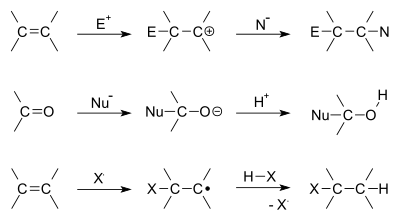Addition reaction facts for kids
In organic chemistry an addition reaction happens when two molecules come together to make a bigger one. This can only happen when one of the molecules already has a double or triple bond. These can be carbon-carbon bonds or even carbon-oxygen, carbon-nitrogen and others. One of the two molecules is called the nucleophile, and this is the one that gives the electrons to the other to make the new bond. The other molecule is called the electrophile, and this is the one that gets the electrons.
An addition reaction is the opposite of an elimination reaction. Common examples of addition reactions are the addition of water across a double bond and the nucleophilic attack on a carbonyl.
See also
 In Spanish: Reacción de adición para niños
In Spanish: Reacción de adición para niños

All content from Kiddle encyclopedia articles (including the article images and facts) can be freely used under Attribution-ShareAlike license, unless stated otherwise. Cite this article:
Addition reaction Facts for Kids. Kiddle Encyclopedia.
